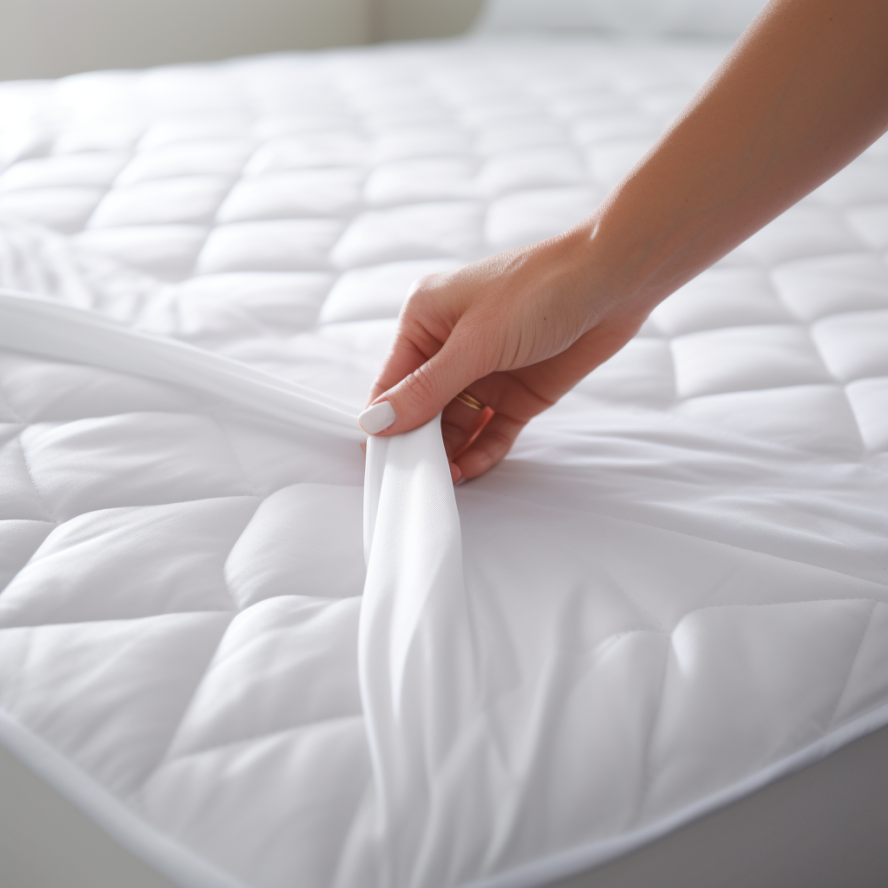If you are looking for a mattress protector that can protect your mattress from spills, stains, dust mites, allergens, and bacteria, you might want to consider 100% polyester microfiber fabric. Polyester microfiber fabric is a synthetic fabric made from very fine fibers, usually polyester, that are woven tightly together. Polyester microfiber fabric has many advantages over other types of fabric, such as cotton or linen, when it comes to mattress protectors. In this blog post, we will explain what polyester microfiber fabric is, how it is used for mattress protectors, and what are the benefits and drawbacks of using it.
How is polyester microfiber fabric used for mattress protectors?
Polyester microfiber fabric is used for mattress protectors because it can provide a barrier to liquid, leaks, sweat, dirt, and allergens. Polyester microfiber fabric is also soft and smooth, creating a comfortable and cozy feel for the mattress. Polyester microfiber fabric can be used for different types of mattress protectors, such as:
- Fitted sheet style: This type of mattress protector slides on snugly to cover the top and sides of the mattress. It is less likely to move around or bunch up.
- Elastic bands: This type of mattress protector lies atop the mattress, held firmly in place by stretch elastic straps on all four corners. The sides are not covered.
- Encased/zippered: This type of mattress protector provides complete coverage to block dust mites, bed bugs, and allergens from getting into the mattress. It has a zipper that closes around the mattress.
- Crib/toddler: This type of mattress protector is sized specifically to fit child-size beds. It is usually lined with a waterproof material to prevent bed-wetting or spills.
What are the benefits and drawbacks of polyester microfiber fabric for mattress protectors?
Polyester microfiber fabric for mattress protectors has many benefits, such as:
- It is very soft and smooth, creating a luxurious feel that rivals silk.
- It is durable and resistant to pilling, fading, shrinking, and wrinkling, making it easy to care for and maintain.
- It is lightweight and breathable, providing comfort and warmth without trapping heat or moisture.
- It is hypoallergenic and antibacterial, preventing dust mites, allergens, and odors from accumulating on the fabric.
- It is affordable and cost-effective, offering high quality at a low price.
However, polyester microfiber fabric for mattress protectors also has some drawbacks, such as:
- It is not very eco-friendly, as it is made from petroleum-based materials that emit fumes and pollutants during production and washing.
- It is prone to static electricity, which can cause sparks, shocks, and clinginess, especially in dry climates or seasons.
- It is not very absorbent, which can make it feel clammy or sticky when wet or sweaty.
- It can trap microplastics, which are tiny pieces of plastic that break off from the fabric and end up in the waterways and oceans, harming the environment and wildlife.
How to choose the best polyester microfiber fabric for mattress protectors?
When choosing polyester microfiber fabric for mattress protectors, you should consider the following factors:
- The type and grade of microfiber. There are different types and grades of microfiber, depending on the material, thickness, and density of the fibers. The most common types of microfiber are polyester, polyamide, and blends of both. Polyester microfiber is the cheapest and most widely used, but it is also the least breathable and absorbent. Polyamide microfiber is more expensive and less common, but it is also more breathable and absorbent. Blends of polyester and polyamide microfiber offer a balance between the two. The grade of microfiber is measured by the grams per square meter (GSM) of the fabric, which indicates the weight and thickness of the fabric. The higher the GSM, the thicker and denser the fabric, and the softer and warmer it feels. However, a higher GSM also means a lower breathability and a higher price. The ideal GSM for microfiber mattress protectors is around 100, which provides a balance between durability and breathability.
- The weave and finish of microfiber. The weave and finish of microfiber affect the texture and appearance of the fabric and mattress protectors. The most common weave for microfiber is the sateen weave, which creates a smooth and shiny surface that reflects light and gives microfiber its luster. However, some microfiber fabrics and mattress protectors are also brushed, which means that the fibers are raised and fluffed to create a softer and fuzzier feel. Brushed microfiber is more comfortable and cozy, but it is also more prone to pilling and shedding. The finish of microfiber can also vary, depending on the treatment and dyeing of the fabric. Some microfiber fabrics and mattress protectors are treated with chemicals or coatings to enhance their properties, such as water repellency, stain resistance, or wrinkle resistance. However, these treatments can also affect the breathability and natural feel of the fabric, and may cause allergic reactions or skin irritations for some people. Some microfiber fabrics and mattress protectors are also dyed with different colors and patterns, which can add variety and style to your products. However, you should also check the quality and durability of the dye, as some microfiber fabrics and mattress protectors can fade or bleed after washing.


